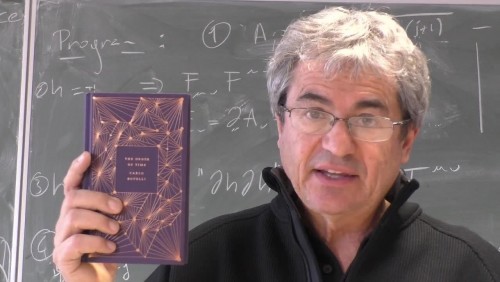Then he flipped the script. "I’m going to tell you that time is not like that," he explained.
Rovelli went on to challenge our common-sense notion of time, starting with the idea that it ticks everywhere at a uniform rate. In fact, clocks tick slower when they are in a stronger gravitational field. When you move nearby clocks showing the same time into different fields—one in space, the other on Earth, say—and then bring them back together again, they will show different times. "It’s a fact," Rovelli said, and it means "your head is older than your feet." Also a non-starter is any shared sense of "now." We don’t really share the present moment with anyone. "If I look at you, I see you now—well, but not really, because light takes time to come from you to me," he said. "So I see you sort of a little bit in the past." As a result, "now" means nothing beyond the temporal bubble "in which we can disregard the time it takes light to go back and forth."
Rovelli turned next to the idea that time flows in only one direction, from past to future. Unlike general relativity, quantum mechanics, and particle physics, thermodynamics embeds a direction of time. Its second law states that the total entropy, or disorder, in an isolated system never decreases over time. Yet this doesn’t mean that our conventional notion of time is on any firmer grounding, Rovelli said. Entropy, or disorder, is subjective: "Order is in the eye of the person who looks." In other words the distinction between past and future, the growth of entropy over time, depends on a macroscopic effect—"the way we have described the system, which in turn depends on how we interact with the system," he said.
Getting to the last common notion of time, Rovelli became a little more cautious. His scientific argument that time is discrete—that it is not seamless, but has quanta—is less solid. "Why? Because I’m still doing it! It’s not yet in the textbook." The equations for quantum gravity he’s written down suggest three things, he said, about what "clocks measure." First, there’s a minimal amount of time—its units are not infinitely small. Second, since a clock, like every object, is quantum, it can be in a superposition of time readings. "You cannot say between this event and this event is a certain amount of time, because, as always in quantum mechanics, there could be a probability distribution of time passing." Which means that, third, in quantum gravity, you can have "a local notion of a sequence of events, which is a minimal notion of time, and that’s the only thing that remains," Rovelli said. Events aren’t ordered in a line "but are confused and connected" to each other without "a preferred time variable—anything can work as a variable."
Even the notion that the present is fleeting doesn’t hold up to scrutiny. It is certainly true that the present is "horrendously short" in classical, Newtonian physics. "But that’s not the way the world is designed," Rovelli explained. Light traces a cone, or consecutively larger circles, in four-dimensional spacetime like ripples on a pond that grow larger as they travel. No information can cross the bounds of the light cone because that would require information to travel faster than the speed of light.
"In spacetime, the past is whatever is inside our past light-cone," Rovelli said, gesturing with his hands the shape of an upside down cone. "So it’s whatever can affect us. The future is this opposite thing," he went on, now gesturing an upright cone. "So in between the past and the future, there isn’t just a single line—there’s a huge amount of time." Rovelli asked an audience member to imagine that he lived in Andromeda, which is two and a half million light years away. "A million years of your life would be neither past nor future for me. So the present is not thin; it’s horrendously thick."
Rovelli’s work as a physicist, in crude terms, occupies the large space left by Einstein on the one hand, and the development of quantum theory on the other. If the theory of general relativity describes a world of curved spacetime where everything is continuous, quantum theory describes a world in which discrete quantities of energy interact. In Rovelli’s words, "quantum mechanics cannot deal with the curvature of spacetime, and general relativity cannot account for quanta".
Both theories are successful; but their apparent incompatibility is an open problem, and one of the current tasks of theoretical physics is to attempt to construct a conceptual framework in which they both work. Rovelli’s field of loop theory, or loop quantum gravity, offers a possible answer to the problem, in which spacetime itself is understood to be granular, a fine structure woven from loops.
String theory offers another, different route towards solving the problem. When asked about what he thinks about the possibility that his loop quantum gravity work may be wrong, he explains that being wrong isn’t the point; being part of the conversation is the point. And anyway, "If we ask who had the longest and most striking list of results it’s Einstein without any doubt. But if you ask who is the scientist who made most mistakes, it’s still Einstein."
How does time fit in to his work? Time, Einstein long ago showed, is relative – time passes more slowly for an object moving faster than another object, for example. In this relative world, an absolute "now" is more or less meaningless. Time, then, is not some separate quality that impassively flows around us. Time is, in Rovelli’s words, "part of a complicated geometry woven together with the geometry of space".
For Rovelli, there is more: according to his theorising, time itself disappears at the most fundamental level. His theories ask us to accept the notion that time is merely a function of our "blurred" human perception. We see the world only through a glass, darkly; we are watching Plato’s shadow-play in the cave. According to Rovelli, our undeniable experience of time is inextricably linked to the way heat behaves. In The Order of Time, he asks why can we know only the past, and not the future? The key, he suggests, is the one-directional flow of heat from warmer objects to colder ones. An ice cube dropped into a hot cup of coffee cools the coffee. But the process is not reversible: it is a one-way street, as demonstrated by the second law of thermodynamics.
Rovelli’s view is that there is no contradiction between a vision of the universe that makes human life seem small and irrelevant, and our everyday sorrows and joys. Or indeed between "cold science" and our inner, spiritual lives. "We are part of nature, and so joy and sorrow are aspects of nature itself – nature is much richer than just sets of atoms," he says. There’s a moment when he compares physics and poetry: both try to describe the unseen. It might be added that physics, when departing from its native language of mathematical equations, relies strongly on metaphor and analogy. Rovelli has a gift for memorable comparisons. He tells us, for example, when explaining that the smooth "flow" of time is an illusion, that "The events of the world do not form an orderly queue like the English, they crowd around chaotically like the Italians." The concept of time, he says, "has lost layers one after another, piece by piece". We are left with "an empty windswept landscape almost devoid of all trace of temporality … a world stripped to its essence, glittering with an arid and troubling beauty".

In the famous Faraday Theatre at the Royal Institution in London, Carlo Rovelli gave an hour-long lecture on the nature of time. A red thread spanned the stage, a metaphor for the Italian theoretical physicist’s subject. "Time is a long line," he said. To the left lies the past—the dinosaurs, the big bang—and to the right, the future—the unknown. "We’re sort of here," he said, hanging a carabiner on it, as a marker for the present.




